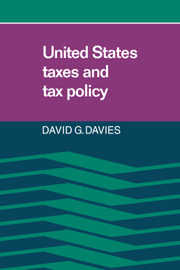Book contents
- Frontmatter
- Contents
- Preface
- 1 Economic foundations of U.S. tax policy
- 2 The individual income tax
- 3 Economic effects of individual income taxes and inflation
- 4 Expenditure versus income taxation
- 5 The taxation of capital gains
- 6 The corporation income tax
- 7 The corporation income tax and inflation
- 8 Social security payroll taxes
- 9 The value added tax
- 10 The sales tax
- 11 State taxes
- 12 Local government taxes
- 13 The distribution of tax burdens
- 14 Status of U.S. taxes and policy
- Appendix
- References
- Index
12 - Local government taxes
Published online by Cambridge University Press: 05 May 2010
- Frontmatter
- Contents
- Preface
- 1 Economic foundations of U.S. tax policy
- 2 The individual income tax
- 3 Economic effects of individual income taxes and inflation
- 4 Expenditure versus income taxation
- 5 The taxation of capital gains
- 6 The corporation income tax
- 7 The corporation income tax and inflation
- 8 Social security payroll taxes
- 9 The value added tax
- 10 The sales tax
- 11 State taxes
- 12 Local government taxes
- 13 The distribution of tax burdens
- 14 Status of U.S. taxes and policy
- Appendix
- References
- Index
Summary
Introduction
Much of government's work gets done at the local level. This fact is reflected in both the structure and sheer numbers of local jurisdictions. Table 12.1 shows the numbers and dynamic character of local governments. The most dramatic change during the twenty years tabulated in the table is the decrease in the number of school districts from nearly thirty-five thousand in 1962 to only fifteen thousand in 1982. This shift reflects the strong move toward consolidation of schools, especially in rural and suburban areas.
The other marked change in the structure of local jurisdictions is the rapid rise of special districts. Special districts are independent, limited-purpose governmental units that have substantial fiscal and administrative independence from general-purpose local jurisdictions, such as counties and municipalities. Most special district governments are created to fulfill a single function, although a few are authorized to provide two or more public services (“Special Purpose …” 1982:3).
Table 12.2 shows both the number and type of functions performed by the nearly twenty-nine thousand special district governments in the United States during 1982. Natural resources is the largest single category. These jurisdictions perform such varied functions as drainage, flood control, irrigation, and soil and water conservation. The other functions are for the most part selfexplanatory. The list does, however, give a feeling for the richness and diversity of the public services that are financed through taxes and fees.
- Type
- Chapter
- Information
- United States Taxes and Tax Policy , pp. 251 - 271Publisher: Cambridge University PressPrint publication year: 1986



